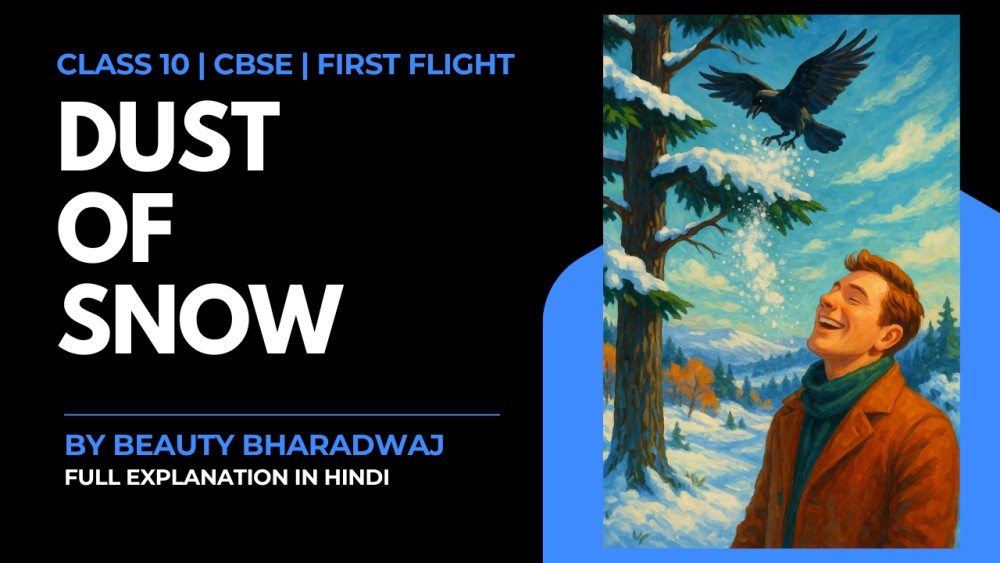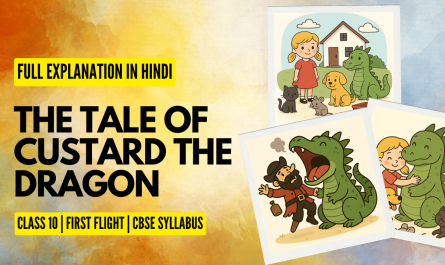Explanation | Summary | Poetic Devices | Main Themes | Class 10 CBSE Syllabus | First Flight
Short Summary of the Poem
Robert Frost’s short poem, Dust of Snow highlights the surprising healing power of nature and its small wonders. Whether it’s a bad mood or even poor health, nature has the magic to lift us up. The poet himself was having a dull, unhappy day when a crow, sitting on a hemlock tree, shook off some snow that fell on him. That tiny moment instantly brightened his mood and made his day better.
What’s interesting is the irony here — the hemlock tree, known to be poisonous, and the crow, often seen as a symbol of fear or bad luck, become the very sources of joy for the poet. Through this, Frost shows that even things usually seen as negative can bring about positivity and change. The message is simple yet powerful: spending time in nature, with all its surprises, can bring peace and happiness anytime, anywhere.
For a detailed explanation of the poem The Power of Music and other poems of class 10 CBSE Syllabus, go to my channel, Beauty Bharadwaj.
Main Themes of the Poem
1. Nature’s Healing Power: Robert Frost’s poem “Dust of Snow” shows that nature has the power to lift anyone’s mood and change their outlook on life, no matter how difficult the situation may be. In the poem, the simple act of snow falling on the poet instantly brightens his mood.
2. Significance of Small Moments: This poem also tells us that even small moments can have a big impact on our lives and can improve our emotional state.
3. Overcoming Negative Associations: In this poem, the poet also shows that symbols usually considered negative — like the crow and the hemlock tree — can also bring positive experiences. It means that in life, not everything is always bad; sometimes those very things can give us happiness and hope.
4. Renewal and Hope: The falling of snow in this poem symbolizes renewal and a fresh perspective. It tells us that even when we feel low, there is always a chance for positive change and a new beginning.

Poetic Devices used in the Poem
- Alliteration- where consonant sound is repeated, for example- “Has given my heart”, “saved some part”, “Shook down on me / The dust of snow
- Imagery- The poetic device in which a picture is formed in the mind of the readers reading the vivid description. For Example- “The way a crow / Shook down on me / The dust of snow / From a hemlock tree” This creates a clear visual of crow shaking off the snow on the speaker.
- Symbolism- Symbolism has been used in the poem to represent ideas or qualities. For example- “crow” aur “hemlock tree” are generally considered negative. Crows is considered as a bad omen and hemlock tree is a poisonous tree.
- Enjambment- In enjambment, a line continues without a pause or punctuation. It helps maintain the flow of thoughts and creates a sense of movement.
- Metaphor- Although a metaphor is not clearly present in this poem, the entire poem itself can be seen as a metaphor — showing how a small, seemingly insignificant event can have a very significant impact on our life.

Line-by-line explanation of the Poem
The way a crow
Shook down on me
The dust of snow
From a hemlock tree
Has given my heart
A change of mood
And saved some part
Of a day I had rued.
Explanation
The poet was in a sad and negative mood while standing near a hemlock tree — a poisonous tree that symbolizes sorrow. Just then, a crow shook a branch and a little snow fell on the poet. Both the crow and the hemlock are generally considered unlucky, gloomy, and inauspicious. But here, the same things turn out to be positive for the poet.

It’s like this — imagine you have a Maths test and your mood is already ruined since morning because of the stress. But when you reach school, you find out that the Maths teacher is absent. The sudden happiness you feel — that’s exactly what Robert Frost experienced. In a moment, his mood and emotions completely changed!
The poet tells us that sometimes even the smallest incidents in life can bring great positivity. Things that we usually think of as unlucky — like a crow or a poisonous tree — can sometimes turn into blessings. The lesson is: stay open to nature’s surprises, because happiness can come to us anytime, from anywhere.

Important Question
In 2022, this question had been asked — ‘How has the poet’s mood changed in the poem Dust of Snow?’
Simple answer: Poet’s mood changed from negative to positive, and his day was saved due to a small incident of a crow shaking of snow on the poet’s shoulder.



